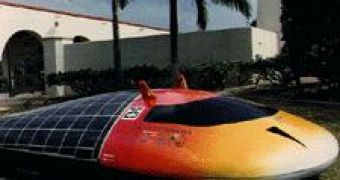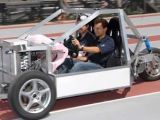21 universities around the world sent 73 students at MIT this summer to design and build vehicles that exploit human power, bio-fuels, solar technologies and fuel cells to travel, with at least 500 miles per gallon of fuel that is. According to vehicle design co-organizer Robyn Allen, a senior in the Department of Aeronautics and Astronautics, ?the MIT Solar Electric Vehicle Team (SEVT) organized the MIT Vehicle Design Summit (MVDS), with the hope of having an impact on not only the field of solar racing but the energy debate as well. Exploring both the socio-political and technical aspects of this work, we are excited to provide a space for students to lend a new voice to the global energy discussion".
SEVT organizers aspire to manufacture solar vehicles that might one day be mass-produced, but for now they must be content with their current cars, optimized to race in the World Solar Car competitions. At the end of the competition, the participants will publish a technical manual of the summit and distribute their findings in the public domain; they also hope to lay the groundwork for more multidisciplinary transportation research in MIT.
To create the vehicles, the students worked with industry and academia mentors. Through a partnership with the MIT Media Lab's Fab Lab, additional cars will be designed to be built in Norway, Costa Rica, India, Ghana and South Africa. The Fab Lab program, part of MIT's Center for Bits and Atoms, explores how information relates to physical representation. The Fab Lab's partner organizations around the world are geared toward allowing ordinary people to design machines for improving the quality of their lives.
Electric vehicles have been around for a very long time. In the early 1900s, there were more electric vehicles than gasoline-powered cars. Gasoline back then was very expensive. It was also hard to start a gasoline engine (the process involved turning a crank in front of the car- maybe you've seen it in old black and white movies.) Also, the cars had no keys, no mufflers, were noisy and put out lots of smoke. Due to this qualities, at one time there were 50,000 EVs on the roads and streets of the United States. Nowadays, automobile companies make more clean and easy to use cars. Ten cars built today produce the same amount of pollution that you'd get from just one car built 15 years ago. And oil companies are creating cleaner fuels, like a new gasoline called 'reformulated gasoline'. But EVs are back on the road. Electric vehicles use electricity stored on the car, in batteries. EVs have an electric motor that turns the wheels and a battery to run that motor. Fortunately, those batteries aren't likely to blow up in your face as those from the laptops.
Other types of electric vehicles are electric-powered buses, trolleys, subways or light-rail. Even most trains are electric. In some places, people use electric buses with batteries, because they don't want wires over the roads. Unfortunately, electric cars will probably not be solar-powered. Solar cells, also called photovoltaic cells, produce too little power. They are not practical to power a full-sized electric car. There is not enough energy to run a heavy vehicle, and due to this restriction, this kind of machines is not too safe in case of a collision with a normal car. In the future, maybe with the lack of gasoline, things will start to shine for the alternative fuel vehicles too, and some big companies (Ford, General Motors, Toyota, Chrysler and Honda) already have in their offer at least one model of an electric car.
Photo credit: www.energyquest.ca.gov; web.mit.edu

 14 DAY TRIAL //
14 DAY TRIAL // 
